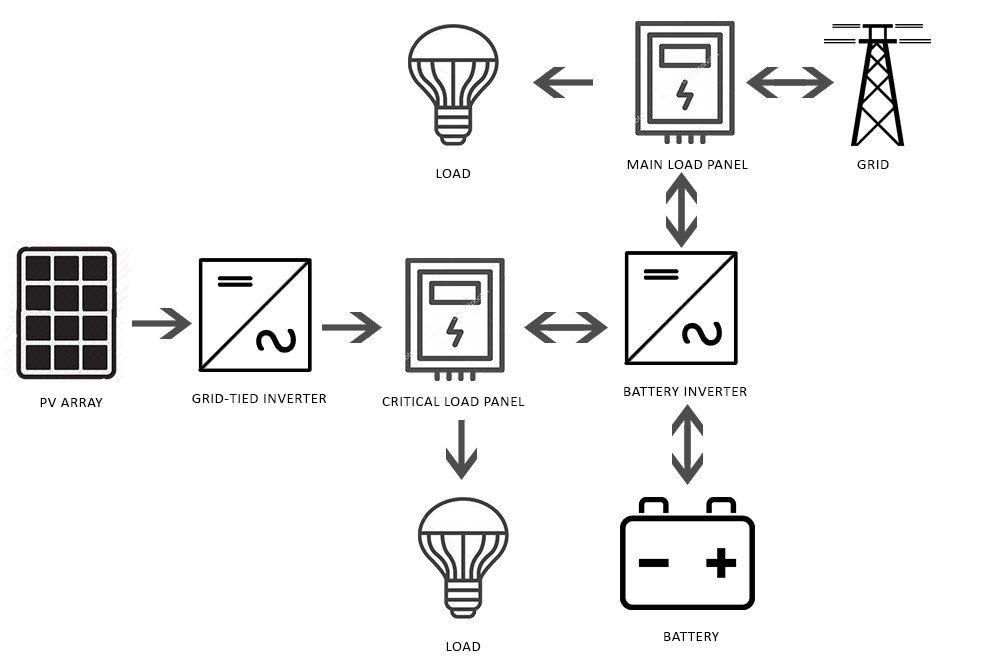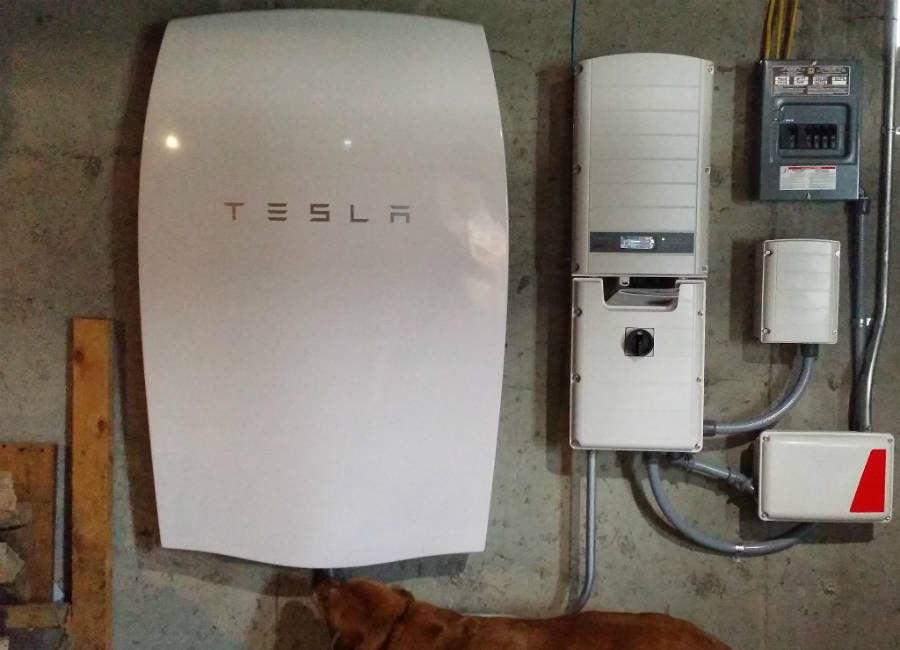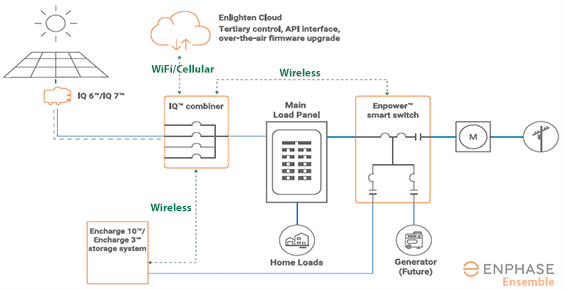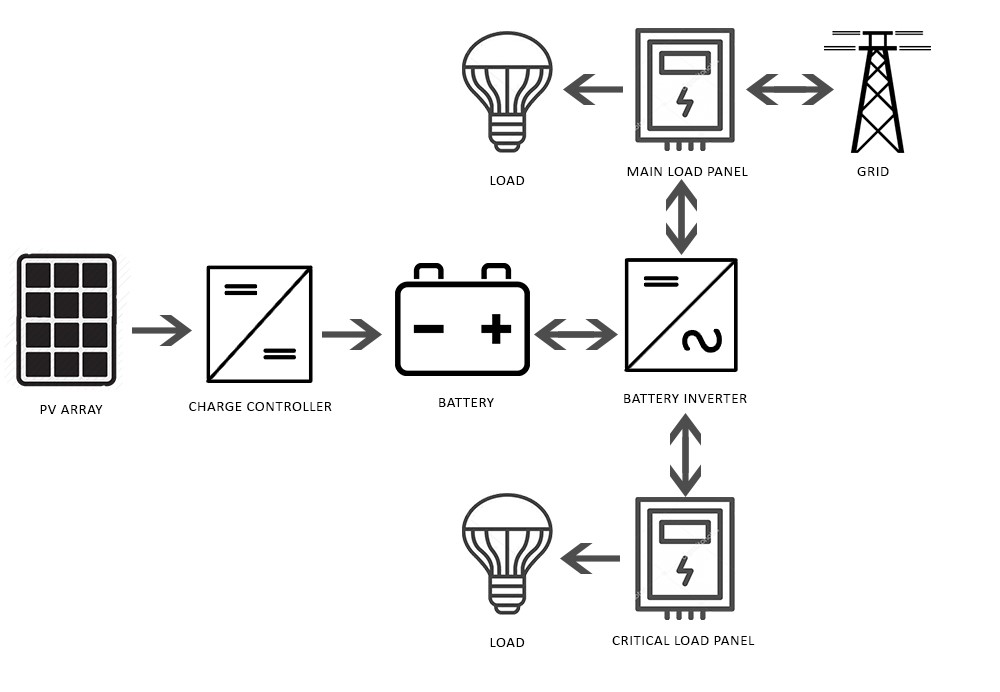In this article, we are going to cover the 2 different types of battery systems that you can choose from. Your application will determine the which one works best for you, so it is important to speak with an energy advisor to make that determination. We will highlight the differences and benefits of each. AC-coupling is currently the most common method in the market, so we will start there first.

An AC-coupled solar + storage system is the most common these days as it was Tesla who popularized it. There are multiple different brands available, but the Powerwall currently reigns. The reason it is so popular is because it can be added to any existing solar system. If you look at the graph above this section, you will see a Hybrid (battery) inverter is used and coupled to both the AC output from an existing solar inverter and to the grid. This hybrid inverter is also DC coupled to the battery system. When installed correctly, this system can provide back-up power, grid shaving, and load shifting even when the grid goes down.
If you follow the flow of electrons you will see how this system works. Solar modules produce DC electricity, next comes the Grid Tied inverter, converting the DC to AC, next the power flows through the critical load panel, into the hybrid battery inverter, and then the power gets rectified (turned back to DC) and then stored in the battery. The power is stored there until needed, and then converted again back into AC power to be used in the AC panels and then supply to the loads.
That is 3 conversions (DC to AC at inverter, back to DC again at hybrid inverter, then back to AC) for every single electron. It is typical to have a 3% loss just in wiring, and each conversion creates an additional 4% loss. So, an AC coupled system, like the Tesla Powerwall, will provide about 15% losses in power for all power produced at the solar array.
The significant difference between the two battery options is that in an AC coupled system, 2 inverters are needed. The grid tied inverter, plus the hybrid (battery) inverter. This is a highly effective means to create back up power and use solar energy if you already have a solar system installed. However, there is a price you must pay for this kind of system. The additional inverter is an added cost, and it has a lower efficiency than the DC-coupled alternative.

Here is an example of a Tesla Powerwall AC Coupled to a SolarEdge inverter. The Powerwall houses a hybrid inverter inside the shell. This system will have an approximately 15% loss of energy from the solar array to the loads inside the home.

AC Coupled Micro-Inverter + Storage System
The above graph is for the Enphase IQ micro-inverter solar + storage solution. This is another AC-coupled solution; however, it is an intelligent and resilient solution. The graph is a simplified graph of the total picture, as it does not show the multiple conversions of the DC power to AC and vice versa as stated earlier. While the total system energy efficiency losses mirrors that of other AC-coupled systems like Tesla, this system provides the highest level of AC power resiliency due to having many smaller inverters throughout the solar and storage systems. With the best-in-class communications abilities and high resiliency, the Enphase IQ storage solution comes in as the highest cost solar + storage solution.

DC Coupled Solar + Storage Solution
Since solar power modules naturally produce DC power, and batteries naturally store DC power, a DC-coupled solar + storage system naturally makes sense and is as you suspect, much more efficient. The DC power from the solar array will directly charge the DC batteries, and this can be done first before any conversion to AC power. So, the only losses realized are the line losses, or about a 3% loss. When energy is needed, only one conversion to AC power is needed, so DC-coupled solar systems boost the highest energy efficiency with losses as low as 7%. Therefore, a DC-coupled solar system provides all the same benefits as the AC-coupled systems but with a lower cost out the gate and higher efficiency. Look below for some product data available as a side-by-side comparison.

Side-by-side comparison:
LG Chem DC Coupled vs AC coupled Powerwall vs Generac PWR Cell DC Coupled
*Notice: Powerwall is not including the losses of the Grid-Tied inverter
**Enphase IQ Ensemble data unavailable
Conclusions
For the average person, this can seem like a lot of information to digest. When you speak with an energy advisor, that professional can lay out the options available as you consider battery options for your home. In all solar systems, there is not a one-size-fits-all approach to how decisions are made. Each system is unique, and each system functions in a way that suits the needs of that house. Plus, with a proper design, you can understand exactly how a solar + storage can work for your home and determine the amount of power you would desire in the case of an outage or for grid-shaving.
If you’re interested in speaking with an energy consultant about what a solar installation would look like for your home, click on the “Get Started” button below.





